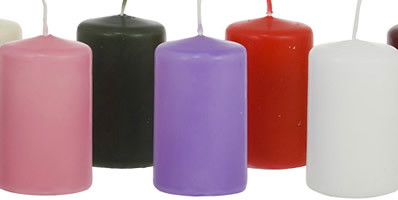Instructions for making Moulded and Round Pillar Candles

SAFETY-FIRST
Candle waxes melts below the boiling point of water, so it is always advisable to melt candle wax over a double boiler to ensure the wax cannot be overheated. It is never recommended to heat candle wax above 90 degC or to a point where it smokes, sputters or vapourises. It is recommended to use a thermometer to monitor safe temperature. It is also advisable to wear gloves and an apron or protective clothing. In the event of a wax fire, turn off the stove, cover with a lid or damp cloth. Never pour water on to a wax
Before you start...
Prepare your working area. Near the cooker or hob is best. If desired, cover the surface with a suitable protective sheet. Remember, spills of wax are easily removed from most surfaces by peeling off while still warm. If left to cool, most can be removed with a suitable plastic scraper. Do not scrape with anything harder than the surface itself or damage may occur. Surplus wax can be kept to re-use. Never pour surplus wax down the sink.
Melting your wax...
It is recommended to use a double boiler to melt wax to avoid overheating. You don't need special equipment, as a double boiler can be easily improvised from common kitchen utensils. Maybe a large heat-proof glass bowl over a slightly smaller saucepan of water? Maybe a heat-proof jug within a slightly larger saucepan of water (don't 'float' the jug). If you really have no way of improvising a double boiler and you choose to heat your wax directly in a saucepan, remember NEVER OVERHEAT YOUR WAX (see SAFETY FIRST above). Make sure you keep your double boiler topped-up with water (from a boiled kettle is ideal). Observe correct 'melt' and 'pour' temperatures for your wax for best results.
Preparing your wick....
If you are not using a pre-waxed wick, you will need to prepare your wick before inserting it into your mould. You may prepare a long length or several short lengths if desired. Simply dip your unwaxed wick into the melted wax and allow excess to drip back into the pan. Remember to allow enough length at each end of your wick to work with. We recommend 2.5cm (1 inch) aprox.
Preparing your mould...
Depending on the type of mould you're using, preparation may vary, but in using any mould (unless it's silicone) it is advisable to spray or otherwise coat the inside of your mould with 'mould release' or a light vegetable oil to prevent the candle sticking to the mould. If you're using a 2 part mould, assemble it now. If using a mould that pours the candle from its top, you will probably use a wick on a 'sustainer' (small metal disc). If using a mould where the candle pours from its base, you will probably be using a wick without a sustainer. Prepare as follows...
With Sustainer...
Pouring a moulded candle into a mould from it's top usually requires a wick on a sustainer. The sustainer is a small metal disc that allows the wick to be 'glued' to the bottom of the mould while it's then held taught, centred and upright with a 'wick holder'. To stick your wick you will need either a small piece of 'wax glue' (a soft wax blend that is quite sticky when worked by hand) or often you can use a small amount of your melted wax. Simply either place a small piece of softened wax glue on the base of the sustainer or dip your sustainer into your melted wax, then press it into place centrally into the bottom of your mould, leaving for a few seconds for it to stick in place (note... silicone moulds work better with melted wax). Once stuck in place you need to keep your wick upright, taught and centred. To do this you use a 'wick holder' which can either be bought as an accessory or improvised. A wick holder is basically 2 small sticks (cocktail sticks maybe) fastened together at each end with somehting flexible (small rubber bands are ideal) that pinches your wick between the sticks, allowing it to be pulled taught and centred by simply resting the wick holder over the top of your mould.
No Sustainer...
Pouring a moulded candle into a mould from it's bottom-end requires a different technique. Your mould will have a small 'wick hole' at the bottom (which will become the top of the candle). You will need to thread your prepared wick through this hole and seal the hole from below with 'mould seal'. Mould seal is simply a sticky mouldable product similar to 'Blu Tak', so any similar product can be used. Always make sure your wick is completely within the mould seal to avoid leaks and press the sealed mould down firmly on a flat surface to ensure it's absolutely upright before filling. The other end of your wick will then require keeping taught and central in the same way as above, so using your wick holder, pinch your wick between the 2 sticks of the wick holder and pull taught, centring your wick and resting the wick holder on the mould.
Pouring the wax...
Having melted your wax, add any candle dye to the wax and ensure it's fully melted and dispersed (see note below), then allow your wax to cool to it's recommended 'pour temperature'. While it's cooling measure and add any candle fragrance or essential oil. To get a meaningful fragrance in a candle you need to add as much fragrance as your wax will allow. Most waxes will take 7-to-8% fragrance before it affects the stability of the wax, so measure out sufficient fragrance or essential oil and add it you your melted wax as it cools. You are now ready to pour your wax.. Carefully and slowly pour your wax into the mould. You want to avoid air bubbles and other 'voids' in your candle, so a slow and steady pour is ideal. Tap the sides of the mould whilst pouring to release any trapped air that may cause bubbles. As wax cools there is shrinkage and different waxes behave differently. It is important to make sure the shrinkage does not result in voids in the candle or an uneven surface (particularly importat if the top of your pour will be the top of the candle). So... Reserver a small amount of the melted wax and keep it melted. As the poured candle cools a skin forms and the skin appears to 'shrink' downward. To keep the surface flat and even, pierce this skin with something like a knitting needle and re-pour a small amount of wax into the holes and over the surface. This can be done more than once if necessary. It is important not to pour above the original fill-height, or your candle could stick to the mould where this new pour line forms. Candles should completely cool before removing from the mould. Overnight is best. If the wax sticks to the mould in any way it can be placed in the fridge to help it shrink from the sides of the mould OR dipped briefly into hot water to help it release.
Cleaning up...
Moulds can be re-used time and time again. It's important to remove all traces of wax before re-use to stop subsequent candles from sticking. Place metal moulds upturned in a warm oven and wipe out with kitchen paper once any remaining wax has melted. Silicone moulds can also be treated this way, despite them being flexible, as they stand high temperatures.. Plastic moulds need more careful treatment and can be placed in hot (not boiling) water and then wiped out in a similar way. Be careful not to overheat plastic moulds or they may distort. Treat latex moulds as you would plastic moulds.
Note...
With most types of wax, as they solidify they turn opaque-to-white, so any colour added will appear a lighter shade as the candle cools.





